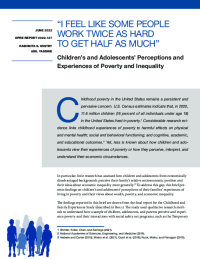“I Feel Like Some People Work Twice as Hard to Get Half as Much"
Children’s and Adolescents’ Perceptions and Experiences of Poverty and Inequality

 Childhood poverty in the United States remains a persistent and pervasive concern. Considerable research evidence links childhood experiences of poverty to harmful effects on physical and mental health, social and behavioral functioning, and cognitive, academic, and educational outcomes. Yet less is known about how children and adolescents view their experiences of poverty or how they perceive, interpret, and understand their economic circumstances.
Childhood poverty in the United States remains a persistent and pervasive concern. Considerable research evidence links childhood experiences of poverty to harmful effects on physical and mental health, social and behavioral functioning, and cognitive, academic, and educational outcomes. Yet less is known about how children and adolescents view their experiences of poverty or how they perceive, interpret, and understand their economic circumstances.
This brief summarizes findings from individual interviews conducted from July 2019 through January 2020 with 47 children and adolescents, ages 7 to 17, about their perceptions of their families’ experiences of living in poverty and their views about wealth, poverty, and economic inequality. The findings are drawn from a larger study—the Childhood and Family Experiences Study—that used qualitative research methods to understand how a sample of children, adolescents, and parents perceive and experience poverty and their interactions with social safety net programs.
Key Findings and Highlights
How children and adolescents perceive their family’s economic circumstances
- Many children and adolescents rated their family’s economic well-being as just below or at the midpoint of a 10-rung ladder. In evaluating their family’s position, they drew on their own experiences and assessed themselves in relation to others they perceived to be better- or worse-off than they were.
- Many children and adolescents were aware that their families struggled economically. They recognized that it was important to place a priority on needs over wants and to be resourceful.
- Many adolescents and some children understood the importance of being resourceful and needing support from others to help manage their family’s economic circumstances.
- Many adolescents, but few children, said that they didn’t ask for things they needed or wanted because they knew their family struggled financially.
- Many children and adolescents knew that their parents worried about finances. They also worried about how much money their family had, though this was true of children more than adolescents.
How children and adolescents perceive poverty, wealth, and economic inequality
- Children and adolescents described wealth and poverty in different ways and the middle class as “average” and “normal.” Adolescents offered more nuanced perspectives than children, noting variability among the rich and the poor.
- Many children and adolescents viewed wealth and poverty as caused by factors within a person’s control (for example, not trying hard enough). Some also mentioned factors outside an individual’s control (for example, being born into a poor family). Adolescents’ responses were more complex and included references to multiple factors.
- Both children and adolescents thought that economic inequality was unfair, children more so than adolescents. They both believed that the government and wealthy individuals should redistribute resources to families who needed them.
Methods
This study used qualitative research methods to center the voices of children and adolescents in both rural and urban contexts in the United States. The research team conducted in-person, semi-structured interviews with at least one child or adolescent in 30 families—10 families in each of three communities (Los Angeles, New York City, South Central Appalachia)—from July 2019 through January 2020.
Interview topics included perceptions and experiences of family economic circumstances and material hardship. Children and adolescents responded to a set of interview questions that used an image of a ladder to learn about what they think about their socioeconomic status relative to others. The ladder’s bottom rung represents families with the least money and the top rung represents families with the most money. In addition, interviewers asked children and adolescents to share their perspectives on what it means to be rich, middle class, and poor, and to reflect on whether they see society as fair and equitable. The research team used an inductive and iterative process to develop codes and analyze data from interview transcripts, and to identify common themes.






